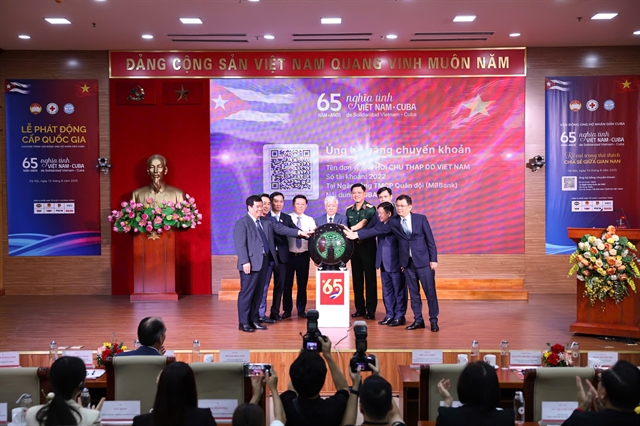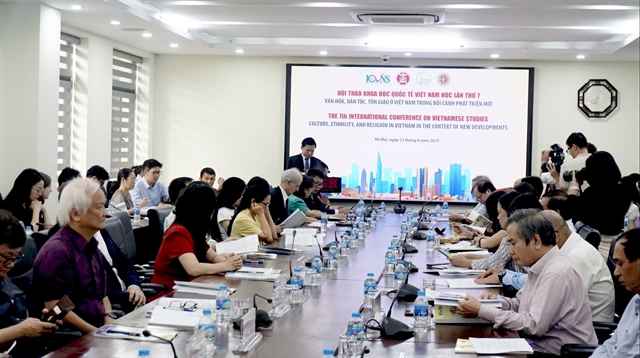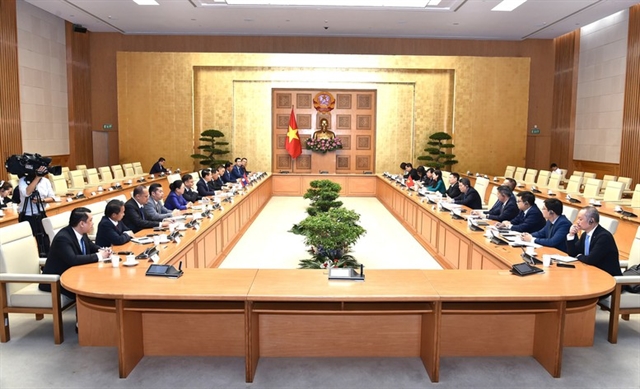 Sunday/Weekend
Sunday/Weekend
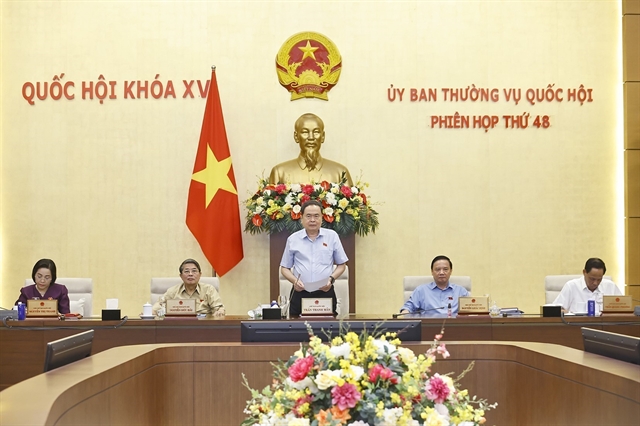
Phương Mai
 |
| FRONTLINE ART: Veteran painter Phan Hữu Thiện (left) explains artist-soldier Trang Phượng's sketches depicting life on the frontline to a viewer at the exhibition 'Kể Chuyện Sau Ngày Thống Nhất' (Telling Stories After the Reunification Day). VNS Photo Phương Mai |
HCM City’s art scene has experienced a remarkable transformation 50 years after the end of the Second Indochina War with the fall of Sài Gòn and national reunification (April 30, 1975 – 2025), contributing to the development of modern Vietnamese art.
As a dynamic hub of innovation and creativity of the country, HCM City (formerly Sài Gòn) has become an attractive destination for established artists and emerging talents, art enthusiasts and galleries from across the country and abroad.
More art exhibitions are held annually to introduce the world’s latest trends and styles, highlighted by new artworks by domestic and international artists.
Nguyễn Xuân Tiên, chairman of the city's Fine Arts Association, said that in the digital era, artists could easily approach global trends to make the city’s art scene vibrant, but still honoured Vietnamese culture imbued with national identity.
Tiên said the establishment of the Liberation Art Chamber in 1962 marked the beginning of HCM City’s art scene.
In the past, artists who were also soldiers on the frontline used pencil, watercolour, or charcoal to depict historic events, Vietnamese soldiers on the battlefield, people engaged in daily activities, beautiful landscapes, and portraits of their comrades and friends.
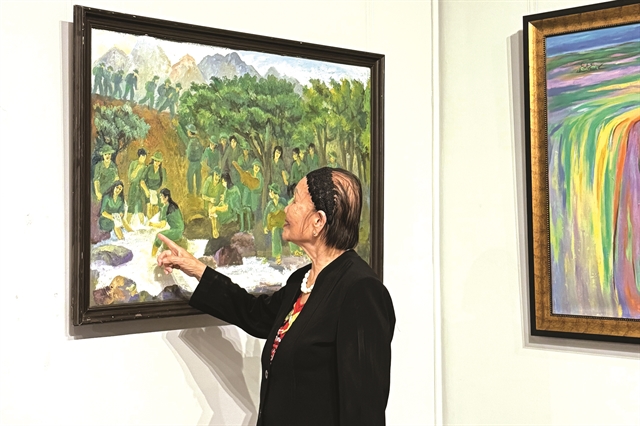 |
| FOREST REST: Veteran painter Nguyễn Thị Hồng Xuân introduces her oil on canvas 'Nghỉ Ngơi Giữa Rừng Trường Sơn" (Taking a Rest in Trường Sơn Forest). VNS Photo Phương Mai |
Painter Nguyễn Thị Hồng Xuân, 82, a member of the chamber, recalled that they faced many challenges at that time. Some artists were art students at home or abroad, and some were self-taught, but their skills were professional, and their paintings were exquisite.
A huge collection of 3,000 sketches is currently preserved at the HCM City Fine Arts Museum. It includes works by Quách Phong, Trang Phượng, Cổ Tấn Long Châu, and Huỳnh Phương Đông.
The museum is displaying part of its collection at the exhibition “Kể Chuyện Sau Ngày Thống Nhất” (Telling Stories After the Reunification Day), until June 8, to help visitors and art lovers learn about truthful moments, the cruelty of war, and the country and the people’s patriotism.
Trần Minh Công, the museum’s deputy director, said that “the exhibition reminds the public of a historical period that has long passed but has never faded, and shows gratitude to soldiers and artists who sacrificed for the country’s peace and independence.”
Fine Arts Association
 |
| HAPPY SCULPTURE: Young art lovers view a lacquer sculpture named 'Hạnh Phúc' (Happiness) by Đinh Văn Sơn at the exhibition named '50 Years of Reunification—Building and Development of HCM City'. VNS Photo Phương Mai |
After national reunification, the artists returned to the city carrying a mission of developing its art scene. Hence, the Fine Arts Association was born in 1981, marking a remarkable transformation for the art scene.
From having only around 300 members in the beginning, the association now has 769 members, including young and veteran artists specialising in painting, sculpture, graphic art, applied art, theory and criticism of fine arts, and galleries.
“The city saw a quick increase in the number of artists, and in the quantity and quality of artworks featuring diverse topics and new genres and trends,” Tiên said.
The city has one of the two leading art schools in the country, the HCM City Fine Arts School, to train young artists, the Fine Arts Museum and dozens of galleries to introduce their works.
The city has over recent years hosted around 200 art exhibitions a year, including 60 events held by the association, showcasing more than 10,000 paintings, sculptures, installations and graphic paintings.
All the artworks are in various materials such as lacquer, oil on canvas, acrylic, wood and metal, and diverse styles of realism, romanticism, impressionism, abstract, semi-abstract and metaphor.
 |
| CARVING PAINTING: 'Bài Ca Thống Nhất Bắc Trung Nam' (A Song of National Reunification), an aluminium bas-relief by Nguyễn Xuân Tiên, chairman of the HCM City Fine Arts Association. |
A special exhibition with the theme “50 Năm Thống Nhất —Xây Dựng và Phát Triển Thành Phố Hồ Chí Minh” (50 Years of Reunification—Building and Development of HCM City) was held last month to encourage reviewing, learning and celebrating the city’s burgeoning art scene over the past 50 years.
The event displayed 22 sculptures and 121 paintings and graphic works by established and young artists, depicting building, developing and protecting the country, boosting science and technology, national security, and a civilised, modern and dynamic HCM City.
Sculptor Trần Việt Hà, who had works displayed at the exhibition, said, “The exhibition left a deep impression on viewers and promoted their love for art, the country and the people.”
In addition, international exchange, cooperation and integration in this field have achieved strong progress since an all round renewal policy was initiated in 1986.
The association has welcomed hundreds of artists from Southeast Asian countries and other countries such as South Korea, Japan, India and Canada to join annual exchange programmes in the city.
Its biggest event was the tenth exhibition of the International Association of Female Artists (IAFA), the world’s only international organisation for women artists, in 2012.
The exhibition attracted more than 220 women artists from 22 countries and territories, including 70 artists of Việt Nam.
The event was recognised as one of the country’s most outstanding cultural events in 2012.
Moreover, Vietnamese artists have had opportunities to absorb new trends, making Vietnamese art closer to the world. Pioneers named artists such as Lê Triều Điển, Nguyễn Hoài Hương and Ly Hoàng Ly.
“All the exhibitions and exchange programmes aim to connect artists in the city and all over the country and the world, and share their works with art lovers,” Tiên said.
Fine Arts Museum
 |
| A corner of an exhibition at the HCM City Fine Arts Museum. VNS Photo Phương Mai |
Due to the city’s commitment to conserving and promoting the valuable artworks and cultural heritage of Việt Nam, the HCM City Fine Arts Museum was established in 1987.
The museum has a huge collection of more than 21,000 art works, ranging from modern paintings and drawings to sculptures dating back to the 4th century, and artworks by foreign artists.
The highlights among them are two national treasures.
One is Vườn Xuân Trung Nam Bắc (Spring Garden of the Centre, South and North), a massive lacquer piece, up to 5.4 metres wide, by Nguyễn Gia Trí (1908-1993), a pioneer in lacquer painting in Việt Nam.
Trí spent 20 years, from 1969 to 1989, completing the nine-panel work, his largest and last painting of Vietnamese women from the central, southern and northern regions wearing the traditional áo dài, walking outdoors and singing happily in a spring landscape.
Mã Thanh Cao, who began working at the museum in 1998 and was its director from 2009 to 2015, commented that the painting showed Trí’s exceptional techniques and expressed his love for the country and desire for a peaceful life.
Vườn Xuân Trung Nam Bắc was first displayed at the museum in 1991 after the city bought it from the artist. It was recognised as a national treasure in 2013.
Another is a lacquer painting called Thanh Niên Thành Đồng (Youth of the Copper Bulwark) by Nguyễn Sáng (1923-1988).
The work, which is 1.45m in height and 2.45m in length, was created from 1967 to 1978, depicting an anti-war protest of Vietnamese students and young people in Sài Gòn in the 1960s.
The painting is one of two of Sáng’s works inscribed on the National Treasure List in 2014. The other is lacquer painting Kết Nạp Đảng ở Điện Biên Phủ (Being Admitted to the Party in Điện Biên Phủ), which is being kept at the Việt Nam Fine Arts Museum in Hà Nội.
The collection of 3,000 sketches during the revolutionary period is another significant holding of the museum since its establishment.
About the collection, Cao recalled that the artists sold their sketches to the museum for a symbolic price, and she was very grateful for their generosity.
"The collection plays an important role in the history of Việt Nam. It helps younger generations learn more about the cruelty of war and appreciate the peace of today,” she said.
The 87-year-old painter Quách Phong said he donated his paintings to the museum in the hope that they would be conserved carefully and their value would be promoted as documents about history, so new generations could understand more about the past.
Over the last 30 years, the museum has collected more than 6,000 Vietnamese paintings and sculptures, mostly done by graduates of the Indochina Fine Arts College (founded in 1925) and Gia Định Fine Arts College (now the HCM City University of Fine Arts), such as Lê Bá Đảng, Trương Hán Minh and Bùi Hải Sơn.
Apart from pieces by Vietnamese artists, the museum has several artworks by foreign artists, such as Oba Shuji and Kato Shojiro from Japan, Laurent Krief from France, and Boris Simionovich Iliukhin from Russia.
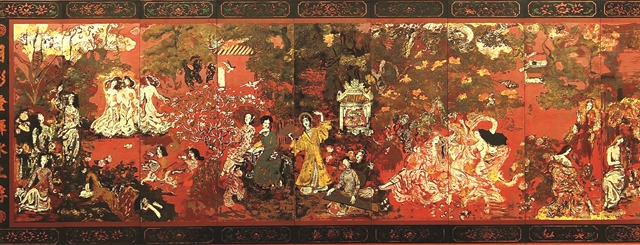 |
| The lacquer painting Vườn Xuân Trung Nam Bắc (Spring Garden of the Centre, South, and North) by Nguyễn Gia Trí, displayed at the Hồ Chí Minh City Museum of Fine Arts. Photo courtesy of the HCMC Museum of Fine Arts |
Development plan
"It is necessary to have policies and guidelines of the State to develop fine arts in the era of globalisation and support artists in creating great works about the country’s development and achievements," association chairman Tiên said.
He also called on artists to constantly develop their skills to increase the quality of their works and improve their knowledge of history and culture to highlight Vietnamese culture imbued with national identity.
The city should launch a long-term project that boosts art education in schools at all levels and adopts a new curriculum to elevate young people’s aesthetic sense.
The city needs more public spaces or festivals for the display of artworks to beautify landscapes, to meet the public’s needs for fine arts appreciation, and to attract international artists.
Tiên said that to achieve the State’s goal of building and developing a progressive Vietnamese culture richly imbued with national identity in the new era, the city has worked closely with art associations, artists and people to improve the city’s art scene, aiming towards "Truth, Goodness and Beauty". VNS

